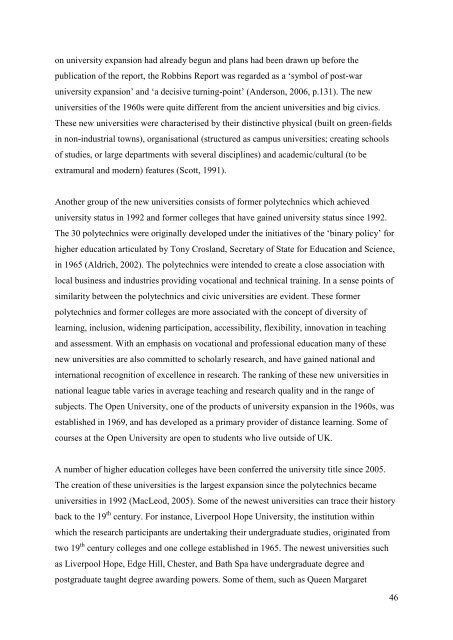The challenge of academic writing for Chinese students within ...
The challenge of academic writing for Chinese students within ...
The challenge of academic writing for Chinese students within ...
Create successful ePaper yourself
Turn your PDF publications into a flip-book with our unique Google optimized e-Paper software.
on university expansion had already begun and plans had been drawn up be<strong>for</strong>e the<br />
publication <strong>of</strong> the report, the Robbins Report was regarded as a ‗symbol <strong>of</strong> post-war<br />
university expansion‘ and ‗a decisive turning-point‘ (Anderson, 2006, p.131). <strong>The</strong> new<br />
universities <strong>of</strong> the 1960s were quite different from the ancient universities and big civics.<br />
<strong>The</strong>se new universities were characterised by their distinctive physical (built on green-fields<br />
in non-industrial towns), organisational (structured as campus universities; creating schools<br />
<strong>of</strong> studies, or large departments with several disciplines) and <strong>academic</strong>/cultural (to be<br />
extramural and modern) features (Scott, 1991).<br />
Another group <strong>of</strong> the new universities consists <strong>of</strong> <strong>for</strong>mer polytechnics which achieved<br />
university status in 1992 and <strong>for</strong>mer colleges that have gained university status since 1992.<br />
<strong>The</strong> 30 polytechnics were originally developed under the initiatives <strong>of</strong> the ‗binary policy‘ <strong>for</strong><br />
higher education articulated by Tony Crosland, Secretary <strong>of</strong> State <strong>for</strong> Education and Science,<br />
in 1965 (Aldrich, 2002). <strong>The</strong> polytechnics were intended to create a close association with<br />
local business and industries providing vocational and technical training. In a sense points <strong>of</strong><br />
similarity between the polytechnics and civic universities are evident. <strong>The</strong>se <strong>for</strong>mer<br />
polytechnics and <strong>for</strong>mer colleges are more associated with the concept <strong>of</strong> diversity <strong>of</strong><br />
learning, inclusion, widening participation, accessibility, flexibility, innovation in teaching<br />
and assessment. With an emphasis on vocational and pr<strong>of</strong>essional education many <strong>of</strong> these<br />
new universities are also committed to scholarly research, and have gained national and<br />
international recognition <strong>of</strong> excellence in research. <strong>The</strong> ranking <strong>of</strong> these new universities in<br />
national league table varies in average teaching and research quality and in the range <strong>of</strong><br />
subjects. <strong>The</strong> Open University, one <strong>of</strong> the products <strong>of</strong> university expansion in the 1960s, was<br />
established in 1969, and has developed as a primary provider <strong>of</strong> distance learning. Some <strong>of</strong><br />
courses at the Open University are open to <strong>students</strong> who live outside <strong>of</strong> UK.<br />
A number <strong>of</strong> higher education colleges have been conferred the university title since 2005.<br />
<strong>The</strong> creation <strong>of</strong> these universities is the largest expansion since the polytechnics became<br />
universities in 1992 (MacLeod, 2005). Some <strong>of</strong> the newest universities can trace their history<br />
back to the 19 th century. For instance, Liverpool Hope University, the institution <strong>within</strong><br />
which the research participants are undertaking their undergraduate studies, originated from<br />
two 19 th century colleges and one college established in 1965. <strong>The</strong> newest universities such<br />
as Liverpool Hope, Edge Hill, Chester, and Bath Spa have undergraduate degree and<br />
postgraduate taught degree awarding powers. Some <strong>of</strong> them, such as Queen Margaret<br />
46


